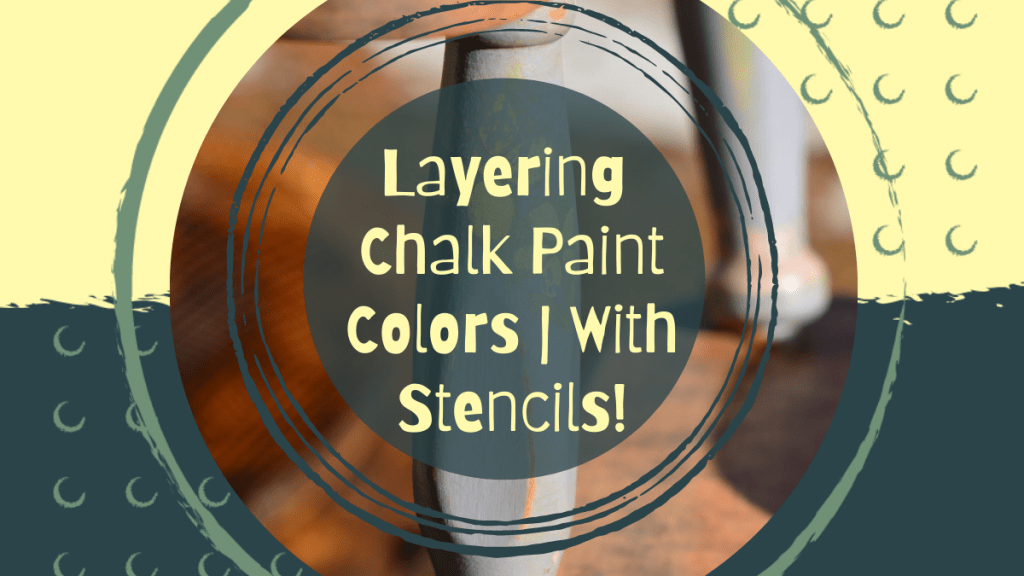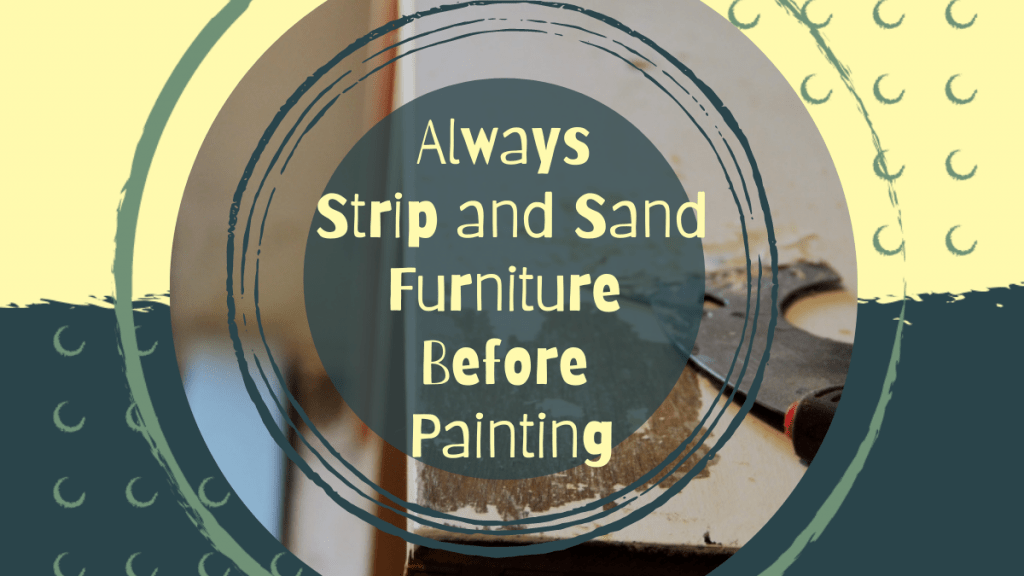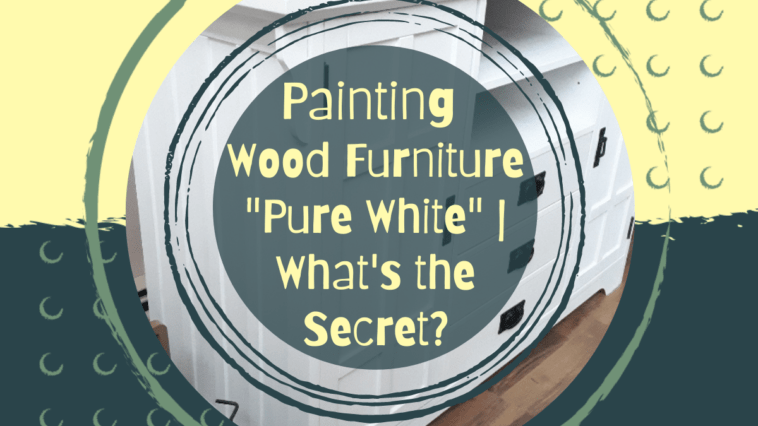
**Heads up: This post contains affiliate links. As an Amazon Associate, I earn from qualifying purchases. Meaning I may receive a small commission– at no cost to you, of course– were you to make a purchase through any of the links. If I link to a product, I use it, I love it, and I think you would too! Please see my Privacy Policy for more details.**
What’s the first word that pops into your head when you think of the color white? For me, it’s “clean”. Maybe you thought of purity, happiness, brightness, goodness, or simplicity? Any of those work.
And yet, unfortunately, painting wood furniture white and keeping it “pure and clean” looking is not the most simple task. But don’t worry, it’s still doable. I’ll be teaching you how I keep that “clean white” look today as we walk through the steps I recently took for my latest commissioned furniture piece.
The customer wanted her TV stand painted all white using Linen White Chalk Paint. This is the original piece:
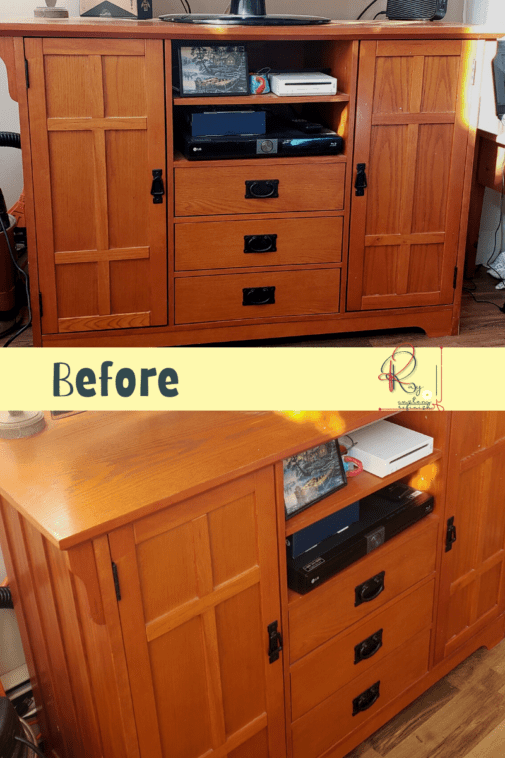
A beautiful piece! But she’s not a fan of the orange-ish coloring of the wood. (I wasn’t a big fan either.) So white it is!
This orange color is an added challenge for me as well, as I will need to take extra precautions not to let the orange dust get anywhere near my white paint or we will not end up with a “pure white” finish at all!
As we walk through painting wood furniture white, we’ll discuss the right prep, the right primer and paint, application, topcoats, and more.
By the end of this post, I hope to have a pure white finished product and I’m confident you’ll never have a problem getting a “pure white” furniture finish again!
Is Your Piece Currently Painted, Stained/Sealed, or Bare Wood?
The info that follows will work no matter the current finish your piece has. But if you’re working with a piece that is already down to bare wood bear in mind a few things:
- Scuff sanding isn’t necessary if the piece is already bare wood. If you got it down to bare wood yourself you most likely sanded it already, but if not, make sure that you’ve sanded it smooth. If you need help sanding your wood furniture properly, check out my post How To Sand Wood Furniture with 5 Game-Changing Tips.
- When using cleansers on bare wood make sure you rinse the surface with water multiple times to be sure no residue remains on the wood. But don’t apply water directly to the wood or you’ll soak it too much! Lightly dampen a clean cloth and wipe the wood that way, just to be safe.
- Water will raise the grain of the wood. To make sure you get a smooth finish, lightly sand the raised grain with 320-grit sandpaper after washing once it has completely dried.
Prepping Your Wood Furniture For White Paint
I can’t stress enough the importance of the first stage of prepping your piece for painting: Clean, clean, clean!
This is actually the first step, the third step, and a couple more steps as well. If you want a “clean” white finish then guess what? You’ll need to keep the surface extremely clean throughout the process!
Before stripping or sanding, use a cleaning solvent to remove dirt and grime from the surface.
There are numerous options here, so I will go over a few of my personal favorites for furniture prep before sanding and painting. A couple of these are deglossers as well, meaning you can skip sanding if you use them. I use them for their cleaning strength alone and usually sand either way just to be safe but that’s your call.
Do NOT sand the piece before cleaning it. If there are any oils, waxes, or built-up residues on the surface and you skip straight to sanding, you’ll end up pushing them deeper into the pores of the wood. This will only make them more difficult– if not impossible– to properly remove.
LA’s Totally Awesome All-Purpose Cleaner
LA’s Totally Awesome All-Purpose Cleaner is a great, cheap product that works awesome! (Hence the name.) It is a non-toxic degreaser, all-purpose cleaner, and spot remover that doesn’t contain bleach, ammonia, or acids.
You can use it on pretty much anything (except leather) but you should dilute it as directed on the back of the bottle. Dilution amounts depend on your surface.
When working with wood it is recommended to dilute 10:1 (water:cleaner). It is a degreaser so it will dull shiny finishes on wood, but this is actually a good thing for us.
That’s why I usually only dilute the cleaner 5:1 when using it for wood prep before painting. If you’re using it as just a cleaner for a wood piece, definitely stick with the 10:1 recommendation.
You can buy it in a spray bottle or in a gallon jug. I find it easier with the jug so you can buy an empty spray bottle to mix the diluted solution in and then use it for application.
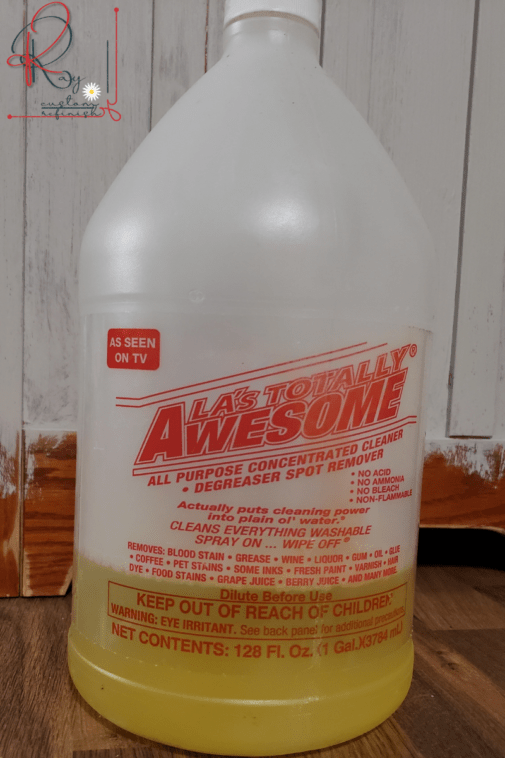
Spray the diluted solution directly onto the surface of the wood, and wipe it off immediately. Be sure to get all the nooks and crannies, and scrub any stuck-on spots. Then use a rag dampened with water only to wipe the surface again and remove any residue that’s leftover.
Jasco TSP Subsitute Prepaint Surface Preparation Cleaner/Deglosser
Jasco TSP Substitute is a bit more heavy-duty than the all-purpose cleaner above. Before using this please be sure to put on chemical-resistant gloves and goggles.
It cleans and deglosses surfaces in preparation for painting, meaning you don’t have to sand the surface after you use this product! It saves time compared to other non-toxic cleaners like LA’s Totally Awesome, but it is heavy-duty, and definitely not non-toxic.
Jasco TSP Substitute also needs to be diluted before use. Mix 1 quart of Jasco TSP Substitute with 4 quarts of warm water. Soak a soft sponge in the mixture and apply it to the surface of the piece. Work in a small area starting from the bottom up. Let it sit on the surface for a few minutes.
Then use another sponge soaked in warm water to wipe the surface. Try to do this one swipe at a time. Don’t wipe back and forth or you’ll only spread the solution around never actually removing any of it. You may need to use multiple sponges to remove everything completely.
You don’t have to rinse before painting but I normally do, just in case. Especially when working with white paint! Take a rag dampened with water, wipe the entire surface one last time, and then let it dry.
As I said earlier, I usually still lightly sand the surface of the piece with 220-grit sandpaper just to be safe, but with this product, it probably isn’t necessary at all.
If you do sand the surface, be sure to do another round with this cleaner and remove any residue of it prior to applying paint.
Krud Kutter Prepaint Cleaner/TSP Substitute
(Above link is for 6 bottles of the cleaner.)
Similar to the Jasco TSP Substitute except Krud Kutter’s cleaner is non-toxic, and not concentrated so you can skip diluting it. Plus, it’s already in a spray bottle. So you can just spray it onto your surface, let it sit for a few minutes, and wipe it off with a clean, dry rag.
It is a deglosser as well and the bottle states that you can paint your surface after only a 10-minute dry time. I’ve found that Krud Kutter’s TSP substitute may not be quite as strong as the Jasco version. This isn’t that surprising considering the difference in chemicals, but it does make me a bit more cautious on skipping sanding completely.
Again, I always lightly sand the surface after the 10-minute dry time just to be safe. A quick scuff sanding with 220-grit should suffice. I follow that with another round of Krud Kutter and wipe off again with a clean, damp rag.
This way there’s less of a possibility that the paint doesn’t adhere due to any remaining gloss. Plus, cleaning the surface twice definitely doesn’t hurt when we’re trying to get our “pure white” finish.
Scuff Sand Any Glossy Surfaces Left After Degreaser/Deglosser
Use your best judgment on whether or not you need to sand the surface after you’ve used the degreaser or deglosser. Degreaser cleansers do dull glossy finishes slightly, but you’ll probably want to scuff sand it still for better paint adhesion.
Unless you’re working on a super large piece, you should be able to scuff sand by hand with just a sanding block using 180-220 grit sandpaper. You don’t need to remove too much of the existing finish, just enough to dull any shiny areas.
If you do decide to use a power sander, I’d recommend no lower than 120-grit to prevent too much finish from being removed. Quickly sand without applying pressure to the sander at all and only a thin layer will be scuffed off the top.
Clean, Clean, and Clean Again – Removing The Sanding Dust Before Applying Paint
Once again wipe down the entire surface with a cleanser to remove all of the dust you just created while buff sanding. This is where I love to use the Totally Awesome All-Purpose Cleanser because it’s not too harsh, but it’s better than plain water.
Something as strong as the TSP Substitute Cleaner isn’t really as necessary here but also wouldn’t hinder your finished product either. The heavy-duty cleansers are really only needed for the first cleaning to be sure you remove any grease or grime from everyday furniture use.
I LOVE using these:
Spray some Totally Awesome on one and wipe down the surface quickly and easily without blowing dust all over the place. Then rinse the duster out with water and wipe down your surface again to remove any residue left from the cleaner.
Repeat this until the duster is as close to clean as possible after wiping down the surface. I usually rinse and repeat at least twice with water only.
Once your surface has dried, you’re ready to apply your primer.
Apply 2 Coats of a Stain-Blocking Primer
I’m not usually a big fan of primer unless I’m painting something that paint doesn’t adhere to well like rusty metal, regular metal, or plastic. Check out my post on Metal Furniture Refinishing for a Which Primer Works Best Cheat Sheet.
When it comes to painting anything white, it’s definitely necessary. Stay away from water-based primers if you plan to paint your piece white. Your best bet is an oil-based primer. But don’t worry, you can use water-based or oil-based paints over the oil-based primer with no problem.
This is my usual choice when priming before white paint:
It’s on the cheaper side, it dries quickly, and perfectly blocks stains and tannins from bleeding through your white paint.
You can also use a shellac-based primer, but they are much more expensive. Unless your piece has some extreme stains or wood knots to cover up, an oil-based primer should work just fine.
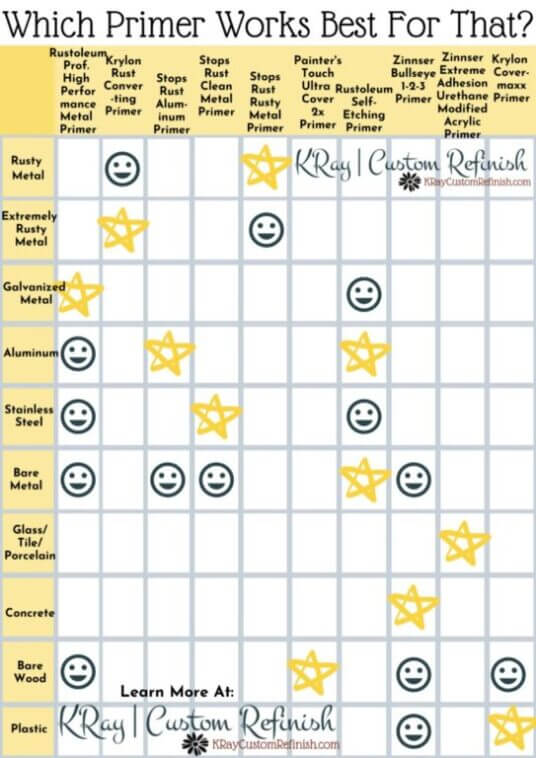
Which Primer Works Best for That?
It’s also not always necessary to use 2 coats of primer, but again, when painting something white, you’re better off applying a second coat.

You’ll save on paint, and make it twice as hard for any stains to bleed through your finish. All it will do is ensure you a beautiful “pure white” finish in the end, so why not, right?
The Best White Paint For Furniture
There are so many amazing furniture paint companies these days it’s honestly hard to go wrong when choosing a paint. I personally am a fan of matte finishes when it comes to white furniture.
Enamels and glossy paints just stand to make imperfections stand out and are much more difficult to apply. So I’ll recommend 3 of my favorite white paints for furniture. Each is within a reasonable budget and easily acquired.
Rustoleum’s Linen White Chalked Paint
This is the paint my client chose for her TV stand I showed you at the beginning of this post.
It’s cheap, easily purchased at most hardware stores, and goes on easily. It does dry quickly so if you have trouble with brush marks just keep your mister handy to prolong the dry time a bit.
I was able to cover the entire TV stand with only 1 quart of this paint. A little goes a long way!
MudPaint Simply White
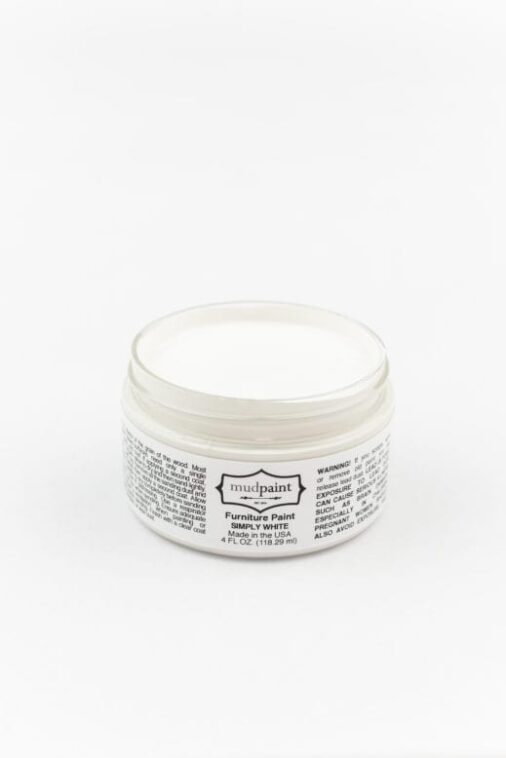
MudPaint is another of my favorite furniture paints. It’s actually a clay-based and water-based paint that covers amazingly well. Their Pure Simply White paint color is just that, simple and pure. Exactly what we’re looking for here!
According to their site, it is their purest white with zero additional tinting as with some of their other white paints. So Simply White is definitely the way to go if you’re looking for a pure white finish.
Fusion Mineral Paint – Casement
Fusion Mineral Paint is steadily moving up on my list of favorite furniture paints. It is incredibly easy to apply without brush marks, and as a painter that does not spray furniture, that’s a big bonus for me.
The biggest thing I had to learn when using Fusion was to put way less paint on the brush than I was used to. They actually have an amazing blog post and a youtube video that explains exactly how to apply their paint. It truly helped me a lot when I first began using their product.
Basically, you want to dip your brush into the paint about halfway up the bristles and no more. Then wipe off any excess paint on all sides of the brush. It might not look like a lot, but you’ll be amazed at how much coverage you can get with that one dip.
Fusion does say that there are no primers needed whatsoever before applying it, but I still recommend sticking with this process when painting furniture white. Especially woods that may have tannin bleed through such as oak, cherry, mahogany, cedar, and walnut.
Not sure what wood type you’re dealing with? Check out my Ultimate Guide To Identifying Wood Types in Furniture or better yet…my 169-page eBook “Grain – Investigating Your Furniture’s Wood Identity” and learn your piece’s wood type PLUS finishing tips for each wood type specifically.
Whichever Paint You Choose, Apply at Least 2 Coats Over the Primer
I’d recommend keeping a brush and roller handy depending on the size of your piece.
You can use a roller for larger surfaces to ensure the smoothest finish possible. A small, High-Density Foam Roller with a thin 1/4″ Nap usually works the best for furniture.
A brand new, synthetic nylon bristle paintbrush will give you the smoothest finish if you’re using water-based paint. For oil-based paints, you should use a natural bristle brush.
Related: The Best Cheap Paints For Refinishing Furniture & More
(Paintbrushes, Wood Stains, Waxes, Clear Coats, and Paints)
Unless you see any serious issues after your first coat, you shouldn’t have to sand between coats at all. If you find paint drips or puddles, use 220 grit very lightly to even the area out.
If you do sand between coats be sure to clean any dust before applying your next coat!
Related: The Best Tools & Supplies For Refinishing Furniture
(Sandpaper, Power Sanders, Paint Stripping Tools, and more!)
The Best Clear Coats For White Painted Furniture
The final and most difficult step to get right when painting furniture white is the clear coat. I love polyurethane for most things. I’ve got an extensive blog post on Applying Oil-based and Water-based Polyurethane Perfectly, but I do not recommend it here.
Polyurethanes, lacquers, and shellacs all have an amber tone to them that deepens wood grain and works great for sealing natural wood and other paint colors. But white paint will turn yellow when coated with these products.
For the 3 white paints I listed earlier, these are the clear coats most compatible and will not turn your finish yellow:
Rustoleum Matte Clear Top Coat
MudPaint Matte Protective Clear Coat
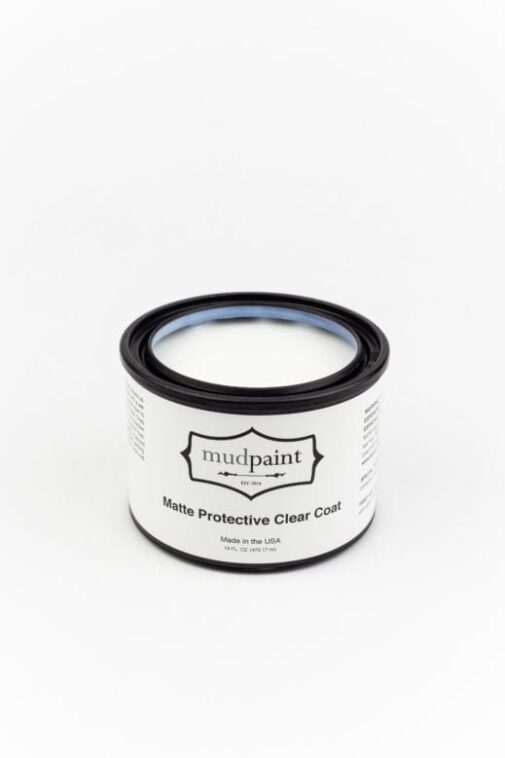
Fusion Mineral Paint Tough Coat Wipe On Poly
These 3 products are quite similar to one another. All work great on light-colored pieces, especially white. They are non-yellowing, water-based polyurethanes meant for use over water-based paints like chalk paint, mineral paint, and Mudpaint.
You can use any of the 3 on any of the water-based paints, I really doubt that the brands have to be used together. It’s recommended but really I wouldn’t worry too much about that.
I personally have found the Rustoleum brand to work best on past projects, but the fact that the price is also the lowest explains mainly why I’ve had more experience with it.
Clear Finishing Waxes For White Painted Furniture
Besides Water-Based Polyurethanes, another option for the best clear coat for white painted furniture is a clear wax. Wax leaves a very unique finished look that some may call “velvety”.
The only thing with wax is that it isn’t permanent like polyurethanes. For high-traffic pieces that will get a lot of wear and tear you might want to stick with one of the polyacrylics listed above. Perhaps even only the top of the piece, just to be safe. Otherwise, you will need to reapply the wax every 6 months or so for continued protection.
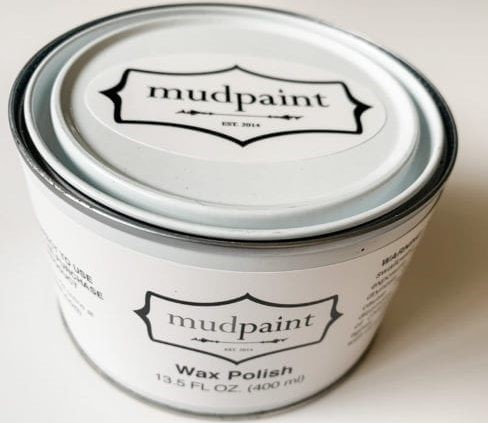
These are my 3 favorites for clear finishing waxes. There are tons of options out there these days. When working with white-painted furniture you want to use something that is definitely clear and won’t yellow over time. I’ve personally tried all 3 of these on white pieces with great success!
Your number 1 priority when painting wood furniture white should be cleanliness. 100%!
It is very easy to smudge white paint with dirty fingerprints or dirty tools! Make sure you use a clean wax paintbrush to apply your wax topcoat, as well as a clean rag for wiping the excess, and buffing the finish once it has dried.
If you’ve kept your work area, tools, and hands (or anything else within a 1-mile radius of your piece, jk) clean, you should end up with a gorgeous, bright, purely clean white furniture piece!
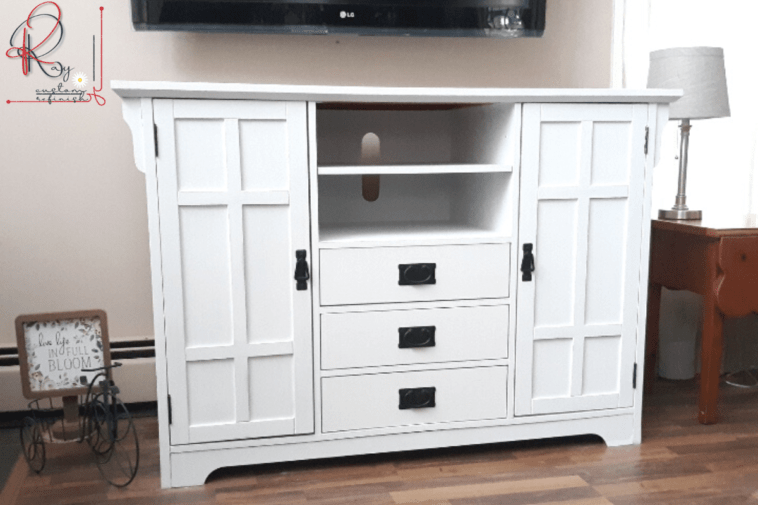
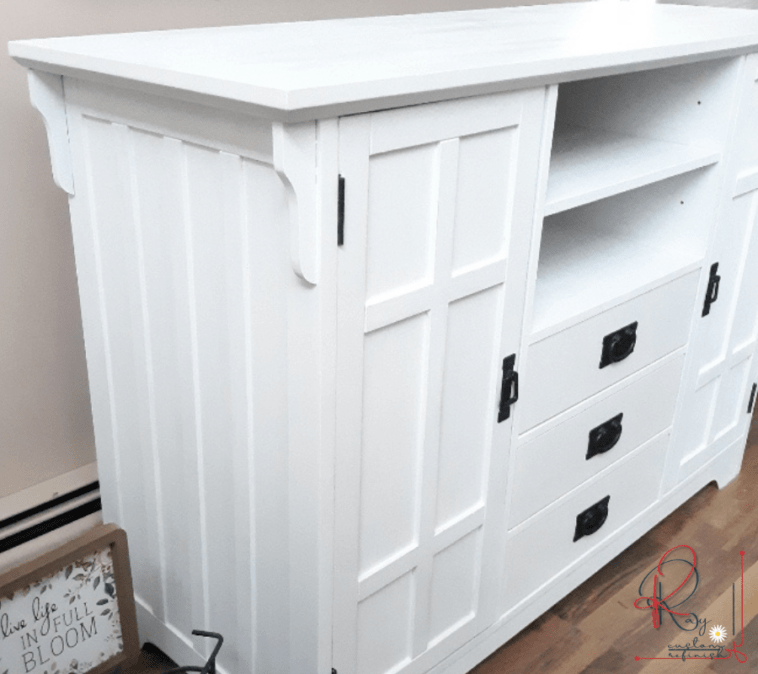

From the brightest orange to the cleanest white. It can be done!
What do you think? Know any other tricks for getting that “pure white” finish? I’d love to hear them if so.
Check out my DIY Resources page for more tips, free downloads, and fresh new product finds to help you on your next furniture refinishing project. And be sure to enter your email below to receive updates on my latest products and posts!
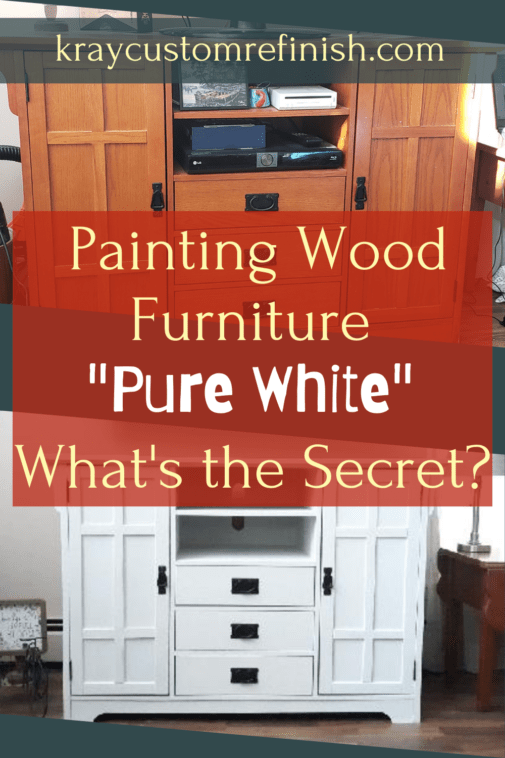
Until Next Time,
KRay


